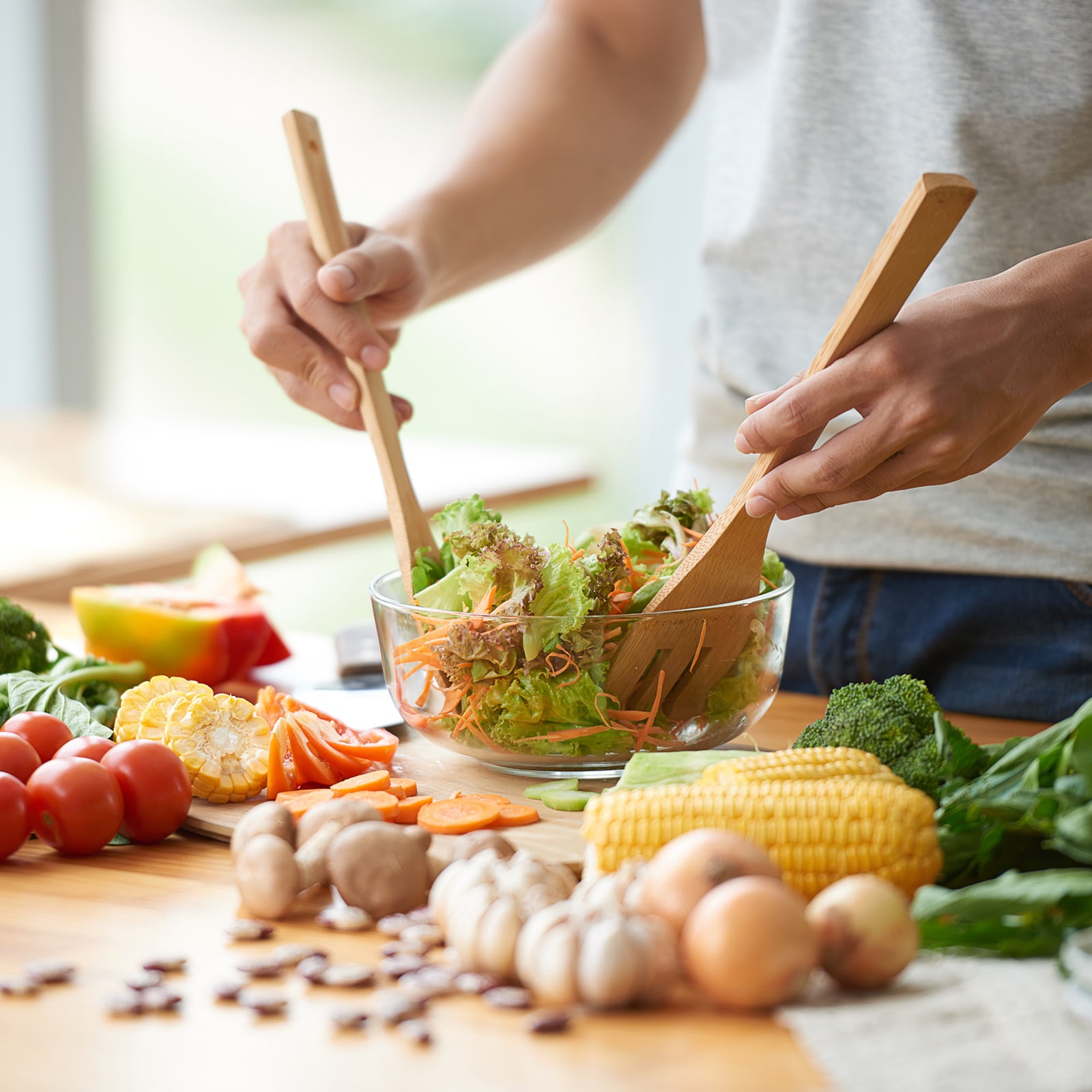
Session 9
Cook To Prevent Diabetes
When trying to prevent type 2 diabetes, you need to eat healthfully. Cooking your own food will give you control over the quality and calories of the food you eat.

Session 9-1
Plan Your Meals
Planning your meals is pivotal in helping you achieve your calorie goals by giving you the opportunity to make healthy choices and avoid the pitfalls that come with impromptu eating.
Plan your meals and snacks for the week. Try to increase the number of times that you prepare your own food. This gives you more control of the quality and calories you’ll be taking in.
Take into account any special events you may have for the week so you can plan to reduce the calories you eat at the event, and/or modify some meals to compensate that day or throughout the week.
Most people eat 2-3 meals a day and may have a snack between meals and/or before bed. This table shows the many opportunities in the course of a week to plan and make better choices.
Here are some ideas for a full week of healthy choices:

| Monday | |
|---|---|
| Breakfast | ● Oatmeal ● Strawberries ● Coffee with skim milk |
| Snack | ● Rice cake with hummus |
| Lunch | ● Checken breast ● Spinach and tomato salad ● Tea with lemon |
| Snack | ● Apple |
| Dinner | ● Black bean burrito with tomato, low-fat cheddar, and salsa ● Sparkling water with lemon |
| Snack | ● Orange |
| Tuesday | |
|---|---|
| Breakfast | ● Nonfat plain yogurt ● Strawberries ● Coffee with skim milk |
| Snack | ● Apple |
| Lunch | ● Turkey sandwich with lettuce and tomato ● Pickle ● Tea with lemon |
| Snack | ● Orange |
| Dinner | ● Peppers stuffed with brown rice ● Salad ● Sparkling water with lemon |
| Snack | ● Baked tortilla chips and salsa |
| Wednesday | |
|---|---|
| Breakfast | ● Oatmeal ● Strawberries ● Coffee with skim milk |
| Snack | ● Rice cake with hummus |
| Lunch | ● Checken breast ● Spinach and tomato salad ● Tea with lemon |
| Snack | ● Apple |
| Dinner | ● Black bean burrito with tomato, low-fat cheddar, and salsa ● Sparkling water with lemon |
| Snack | ● Orange |
| Thursday | |
|---|---|
| Breakfast | ● Oatmeal ● Strawberries ● Coffee with skim milk |
| Snack | ● Rice cake with hummus |
| Lunch | ● Checken breast ● Spinach and tomato salad ● Tea with lemon |
| Snack | ● Apple |
| Dinner | ● Black bean burrito with tomato, low-fat cheddar, and salsa ● Sparkling water with lemon |
| Snack | ● Orange |
| Friday | |
|---|---|
| Breakfast | ● Oatmeal ● Strawberries ● Coffee with skim milk |
| Snack | ● Rice cake with hummus |
| Lunch | ● Checken breast ● Spinach and tomato salad ● Tea with lemon |
| Snack | ● Apple |
| Dinner | ● Black bean burrito with tomato, low-fat cheddar, and salsa ● Sparkling water with lemon |
| Snack | ● Orange |
| Saturday | |
|---|---|
| Breakfast | ● Nonfat plain yogurt ● Strawberries ● Coffee with skim milk |
| Snack | ● Apple |
| Lunch | ● Turkey sandwich with lettuce and tomato ● Pickle ● Tea with lemon |
| Snack | ● Orange |
| Dinner | ● Peppers stuffed with brown rice ● Salad ● Sparkling water with lemon |
| Snack | ● Baked tortilla chips and salsa |
| Sunday | |
|---|---|
| Breakfast | ● Nonfat plain yogurt ● Strawberries ● Coffee with skim milk |
| Snack | ● Rice cake with peanut butter |
| Lunch | ● Veggie soup from freezer ● Pita chips ● Tea with lemon |
| Snack | ● Apple |
| Dinner | ● Chili from freezer with salsa, low-fat cheddar, and tomato ● Skim milk |
| Snack | ● Air-popped popcorn |
Make “Meal Prep” work for you
Meal prepping is the idea of preparing entire meals or dishes ahead of time. It saves you time and money and avoids the daily “what’s for dinner” stress. Having pre-prepared meals on hand can also help you reduce portion sizes and reach your weight loss goal.

Come up with 2-3 meal combinations and cook multiple things on a day where you have some extra time.
Don’t meal prep more than 5 days worth of food. Most of the food you will prep won’t last more than 3 days in the fridge, so make sure you freeze the rest.
Preferably use glass containers that you can eat out of after reheating, and are easily washed and reusable.
Prep for the meals for which you most often end up eating out, overeating or are rushed. Keep within your calorie goal for each pre-portioned meal.
If you have difficulty thinking of meal options, consider signing up for a healthy website (Cooking Light Magazine or Weight Watchers) that will send ideas and recipes directly to your inbox.
Healthy Shopping Tips
You can shop for healthy food without spending a lot of time or money. Try these tips:
Before You Shop
- Make a list of the items you need for the meals and snacks you planned.
- Check your kitchen to see what you already have.
- Keep in mind what’s in season and/or on sale and incorporate them into your meal plan. Farm stands may be a good option too.
- If a store you like offers a discount card, get one.
- Gather coupons for healthy items.
- Find recipes online, books, and magazines. Or swap ideas with your friends and family.
- Have a healthy snack so you won’t be too hungry. This will help you make healthy choices.
While You Shop
- Shop the perimeter of the supermarket where you will find fresh produce, meats/seafood and dairy. Try to limit items from the center isles where you’ll find pre-packaged foods, cookies, sodas etc.
- Use food labels to help you choose healthy items.
- Look for the lowest unit price. You’ll find it on the shelf by the item. It tells how much the product costs per pound, per ounce, etc.
- Stick to your list. Stay away from aisles that tempt you.
- Buy veggies and fruit that are in season or frozen. They cost less and taste better. If you choose canned, avoid those with added salt or sugar. Or rinse them well.
- Choose family packs, store brands, and sale items. These often cost less.
- Avoid prepared meals, like canned soup and frozen dinners. They are often high in calorie and sodium
- If an item is at a good price, buy as much as you can and freeze or store.
